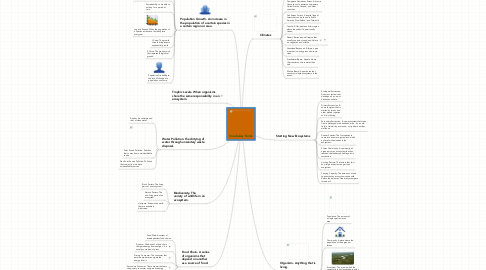Vocabulary Terms
by Guy Mann

1. Food Chain- A series of organisms that depend on another as a source of food.
1.1. Food Web- A system of interdependant food chains.
1.2. Producer- The base of a food chain that gets energy from sunlight. It is usually some kind of plant.
1.3. Primary Consumer- The consumer that eats the producer, and gets the energy from it.
1.4. Secondary Consumer- The consumer that eats the primary consumer and gets its energy.
1.5. Tertiary Consumer- The consumer that eats the secondary consumer and gets its energy.
2. Trophic Levels- When organisms share the same responsability in an ecosystem.
3. Biodiversity- The veriety of wildlife in an ecosystem.
3.1. Biotic Factors- The living parts of an ecosystem.
3.2. Abiotic Factors- The non-living parts of an ecosystem.
3.3. Hotspots- Areas in the world that are extremely biodiverse.
4. Population Growth- An increase in the population of a certain species in a certain region or area.
4.1. Black Plague- A major disease in Europe that killed millions of people and greatly decreased the world population.
4.2. Industrial Revolution- A time period that greatly increase the world population because machinery was doing the extremely dangerous and life threatening jobs.
4.3. Exponential Growth-When the growth of a species becomes more and more rapid every year.
4.4. Sustainability- to be able to hold up for a period of time.
4.5. Logistic Growth- When the population of a species increases at a steady rate every year.
4.6. J-Curve- The growth curve that represents exponential growth.
4.7. S-Curve- The growth curve that represents logistical growth.
4.8. Population Growth Rate- the rate of change of a population over time.
5. Water Pollution- the dirtying of water through unsanitary waste disposal.
5.1. Aquifer- An underground river of clean water.
5.2. Point Source Pollution- Pollution that comes from one identifiable source.
5.3. Non-Point Source Pollution- Pollution that comes from multiple unidentifiable sources.
6. Organism- Anything that is living.
6.1. Population- The amount of a single species in one area.
6.2. Community- A place where the population of the organism thrives.
6.3. Ecosystem- The area in which the community is and everything inside it depends on one another.
6.4. Biome- The region where the ecosystem thrives.
6.5. Biosphere- The area in which the biome is in.
7. Climates
7.1. Rainforest- a forest with heavy annual rain.
7.2. Temperate Deciduous Forest- A biome that is found in eastern and western United States, Canada, and other countries.
7.3. Coniferous Forest- A tropical type of forest that can be found in South America, New Zeland, and Tazmania.
7.4. Tundra- A flat, treeless, Arctic region where the subsoil is perminantly frozen.
7.5. Desert- Barren and dull region that usually consists of sand and little to no vegitation and wildlife.
7.6. Grassland/Savannah- A large, open area that is mostly grass and some trees.
7.7. Freshwater Biome- Aquatic biome that consists of more water than salt.
7.8. Marine Biome- Aquatic area that consists multiple ecosystems in the ocean.
8. Starting New Ecosystems
8.1. Ecological Succession- A new ecosystem that develops on a new or destroyed surface.
8.2. Primary Succession- A new ecosystem that is started by lycans and other pioneer species until it is thriving.
8.3. Secondary Succession- A new ecosystem that starts from a destroyed or abandoned area. Ex. an old field, a field hit by a tornado, a city after a nuclear meltdown.
8.4. Pioneer Species- The first species to come into a new ecosystem and make a place for themselves in the ecosystem.
8.5. Climax Community- A community of organisms or an ecosystem that has reached the farthest possible point in succession.
8.6. Limiting Factors- The factors that limit how large a species can get in an ecosystem
8.7. Carrying Capacity- The ammount of one species that an ecosystem can handle before the balance of the ecosystem gets thrown off.


